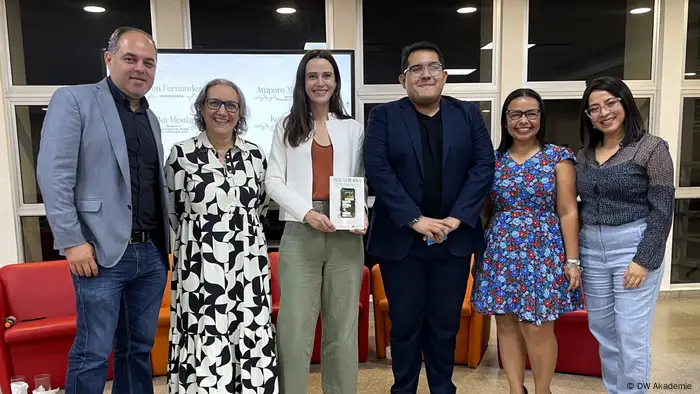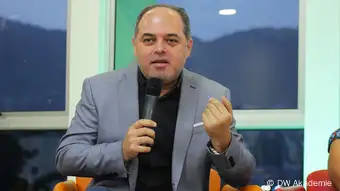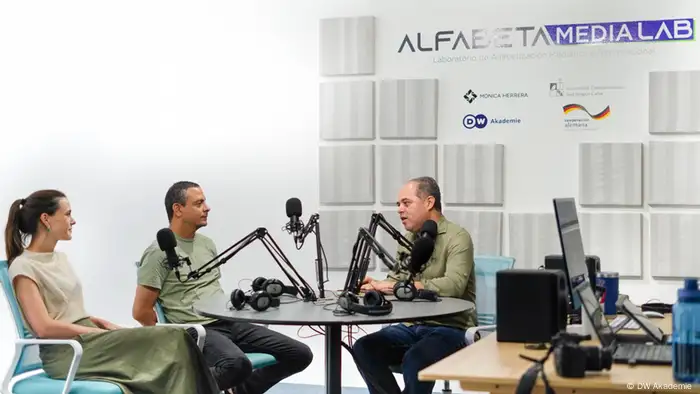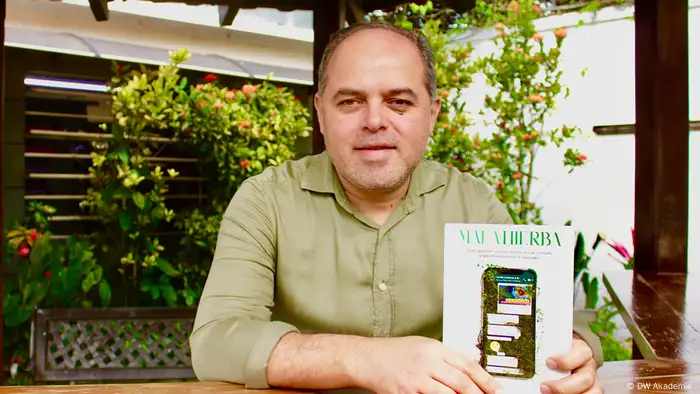INTERVIEW
Willian Carballo is uncovering the life cycle of disinformation in El Salvador
To fully understand disinformation, the team of Alfabeta Media Lab in El Salvador has published a new book. Interviewee Willian Carballo is co-author of this pioneering research.
Disinformation is affecting free decision-making on a global scale, with particularly notable consequences in countries such as El Salvador, where journalism is under great political pressure.
The book “Mala hierba: cómo germina, crece, se reproduce y combate la desinformación en El Salvador” (“Weeds: How disinformation germinates, grows, reproduces and fights in El Salvador”) maps the current situation of disinformation in the Central American country. Using innovative approaches from the fields of psychology and data science, the book seeks to understand the life cycle of disinformation at the national level, from its birth to its possible disappearance.
DW Akademie spoke with William Carballo, MIL specialist and co-author of the book, to discuss disinformation in the Central American context.

Julia Manske of DW Akademie (center) accompanied the authors at the presentation of "Weeds" (from left): Willian Carballo, Amparo Marroquín, Omar Luna, Karla Ramos and Erika Mestizo
DW Akademie: How does the term “weed” relate to disinformation?
William Carballo: In a garden, there are flowers and plants that serve useful and positive functions for the ecosystem, that represent useful information. But there are also weeds – information that harms, misinforms or is not rigorously researched. And no matter how much it is pulled up again and again, it has to be uprooted to be eradicated. Such is disinformation.
In academia, we have tried to go beyond the concept of fake news when talking about disinformation, because the phenomenon is much broader and includes different information disorders.
Disinformation has become an ever-expanding phenomenon. What are the biggest questions that still need to be answered?
We are saturated with political, health, scientific, economic and cultural messages and, with the advance of artificial intelligence and the growing popularity of social networks as viral and frenetic as TikTok, it is increasingly difficult for audiences to determine what information is real and accurate and what is not.
There are still many questions to be answered, such as further research on the use of AI to generate images to confuse or conduct specific studies on certain social networks. Yet in the book we set out to understand at least three basic aspects: how disinformation germinates, how it grows and how disinformation can be combated, just as we would do with a weed in a garden.

During a presentation of "Weeds," Carballo emphasized the importance of disseminating MIL in El Salvador
For your research, you included a behavioral psychologist. What does her perspective add?
Our information processing is not only rational; it is also very emotional. That is why we included this perspective from psychology, which had previously never been integrated into research on disinformation in El Salvador.
The work consisted of analyzing the emotions and cognitive biases that are present when consuming disinformation. The interesting thing is that young people often do not share disinformation out of bad intentions or because they innocently fall into it, but simply because they find a story amusing, for example. Measures to curb disinformation must take these circumstances into account.

Julia Manske and Edgar Zamora Orpinel of DW Akademie interview Carballo in the Alfabeta Media Lab studio
In addition to this book, you co-wrote another on artificial intelligence. How does the technology relate to disinformation?
Nearly half of the population surveyed in that book stated that, at some point in their news consumption, they thought a piece of information was real before realizing it was the product of AI. The technology is influencing more misinformation in the media, especially in the topics of entertainment, politics and science.
But it can also be used in a positive way, for example, to counteract the same misinformation. It can indicate if certain information has the necessary elements to be reliable, if a photo has already been published in another context, if the date corresponds to the event, if the information has three contrasted sources, etc.
AI is neither good nor bad, just as with social media, it depends on how it is used, and it has great potential.
What are the next steps to protect audiences from the risks of the digital world?
The first thing is to promote media and information literacy in audiences. It is very difficult to ensure that disinformation does not occur, because it involves many interests. And the verification of information – fact-checking – takes place when the damage is already done. It is like when you are already sick and then are given a vaccine for the illness. Therefore, the key is to provide the population with the necessary tools to identify disinformation and to be able to determine that a piece of information is misleading, manipulative or conveys hate speech.
In addition, we must communicate better what we already know. Through Afabeta Media Lab, we do many workshops with young people in the interior and rural areas of the country, but it is not enough. The book says it clearly: disinformation actors are creative and get people hooked, yet fact-checkers and academics are still too serious.
Why don't we turn the issue around and speak to young people in another language? That is the great challenge: to convert the results of the book into much more digestible products so that young people can be trained in media and information literacy.
Willian Carballo is part of the Alfabeta Media Lab coordinating team and is director of the research department at the Escuela Mónica Herrera. Alfabeta Media Lab is an innovation laboratory for media and information literacy (MIL) created by the Escuela Mónica Herrera, the Universidad Centroamericana José Simeón Cañas (UCA El Salvador) and DW Akademie. This project is funded by the German Federal Ministry for Economic Cooperation and Development (BMZ).
DW recommends
Audios and videos on the topic
- Date 22.08.2024
- Feedback: Send us your feedback.
- Print Print this page
- Permalink https://p.dw.com/p/4jlWT
- Date 22.08.2024
- Send us your feedback.
- Print Print this page
- Permalink https://p.dw.com/p/4jlWT

